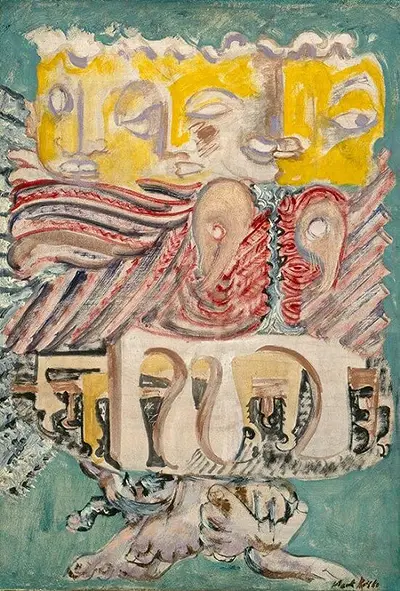The Omen of the Eagle
Mark Rothko, a Russian by birth, migrated to America with his father and mother, where he studied painting. Mark Rothko crafted several artworks in his lifetime and is among America's most brilliant abstract painters in history.
During World War 2, Mark Rothko worked on the painting named The Omen of the Eagle. This period in Mark Rothko's career represents his surrealist years. In this period, his paintings were mainly inspired by Greek mythology and religious monograms.
The Omen of the Eagle is a symbolic piece of artwork that has a deeper meaning based on myths. The picture is obtained from the reliance that reality is identical to divinity. The art shows one can merge man with various environmental instruments to form one disastrous idea.
Mark Rothko got his ideas for this painting from the ordeals that were happening during World War 2, a lot of deaths occurred during the war, and Mark Rothko decided to base his artwork on the emotions of the people.
The Omen of the Eagle is a painting that Mark Rothko painted by inspiration from the conflict between America and Germany. The eagle is a national symbol in the two countries; since Mark Rothko saw this war as dissension of cruelty and civilization, he decided to combine that ferocity and refinement into a simple figure and painted The Omen of the Eagle.
Mark Rothko got inspired by the artworks and projects of early surrealists like Max Ernst and Joan Miro; during world war two, he started painting art with darker themes. He would introduce death themes and combine them with survival in his artworks using notions from ancient mythical beliefs. The art The Omen of the Eagle was painted to show the people's emotions; that's why most art lovers who go to view the painting end up in tears, the main objective of the art was to capture people's emotions unrealistically.
As an abstract painter, Mark Rothko inspired many artists such as Helmut Federle, a Swiss painter; Charles Gibbons, a non-representational abstract painter born in Montreal and Michel Majerus, who combined painting with digital media in his work. The artists were inspired by Mark Rothko's work and followed in the footsteps with great passion.
The Omen of the Eagle is one among many pieces of art that Mark Rothko worked on and was preserved in the Guggenheim Museum located in New York City. Mark Rothko continued lifting his career till his demise in 1970 after committing suicide. His work was left under the able hands of his family and various museums worldwide.


